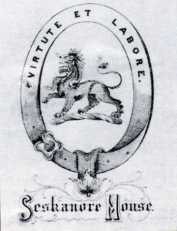Alex Watson is a researcher and genealogist, based in Glasgow, Scotland, I hope that you find this website informative, it is an ongoing project, based on the research that I started, in 2004, on behalf of my friend Patrick Joynson-Wreford, it will continue to be updated as more information becomes available.
Please get in touch if you want to ask questions or need some help, also if you have any information, stories, photographs, etc, that you want to share.
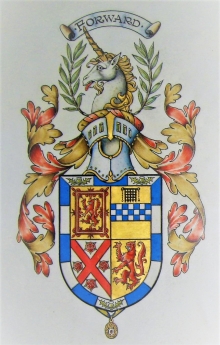
Stewart of Athenree
co. Tyrone.
ANDREW STEWART, (commonly styled captain Andrew Stewart,) who, with lord Castle Stewart, to whom he was related, and his (Andrew's) brother James, who afterwards fixed his residence at Ballymona, co. Tyrone, went from Scotland to Ireland about the year 1627: on his marriage (hereafter mentioned,) he obtained from lord Castle Stewart the greater part of the manor of Castle Stewart; but he afterwards built, and resided on, another seat, called Gortigil, near Stewart's Town co. Tyrone (at a spot immediately adjoining the present residence of the Castle Stewart family,) which has ever been in possession of captain Stewart's descendants: he served with colonel Robert Stewart, of Fry, in defence of the forts of Dungannon and Mountjoy in 1641; and at the rising of the rebels ar Artrea, or Ardtreigh, co. Tyrone, for the purpose of destroying the protestant families of that county, his house was attacked: but with a few Scots' followers he defended it for two days, when assistance was sent to him from Mountjoy Fort.
Captain ANDREW STEWART, m. Sarah, eldest daughter of Andrew Stewart, 3rd Baron Castle Stewart, Co. Tyrone, and Joyce Blundell, daughter and heiress of Sir Arthur Blundell. (Sarah's sister Mary, m. Henry Howard, 5th Earl of Suffolk), and had issue;
- Robert, whose only child, Janet, m. in 1684, John Bell, of Mullantear, Esq.
- Hugh, of whom hereafter.
- James, a naval officer, slain in battle. He m. a daughter of Admiral Sir Cloudesley Shovel.
Captain Stewart having long been an object devoted to vengeance for the zeal and loyalty evinced in the royal cause, was at length, put to death by rebels about the year 1650. His second son,
HUGH STEWART of Gortigil, m. Margaret, daughter of Thomas Morris, of Mountjoy Castle and had with 3 younger sons:
JOHN STEWART of Gortigal, b. 1681; m. 1710 Mary Kennedy, of Scotland, and had with five daughters and another son:
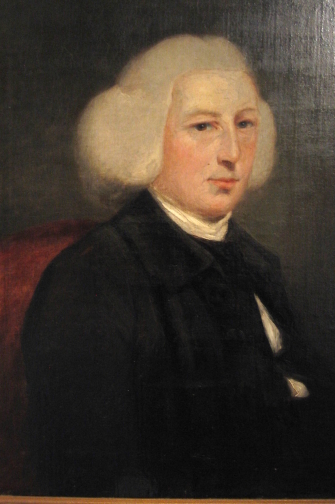
Rev. Hugh Stewart of Termon
b. 1711, d. January 1800
Rev. HUGH STEWART, b. 1711, Rector of Termon, Co. Tyrone; m. 1755, Sarah, daughter of Rev. Andrew Hamilton, (rector of Toboyne and Donogheady, both in the presentation of the Abercorn family in Ireland) capt. Andrew Stewart,) by his 1st wife, the sole da. and h. of sir William Cunningham, of Cunningham Head, in North Britain, and of Castle Conyngham, co . Donegal, bart. (Debretts Baronetage of England, 1839), he d. January 1800, having had issue;
- JOHN, his heir;
- Andrew, East India Company;
- Henry (Rev), Rector of Loughgilly, Co Armagh;
- Ann;
- Sarah;
- Amelia.
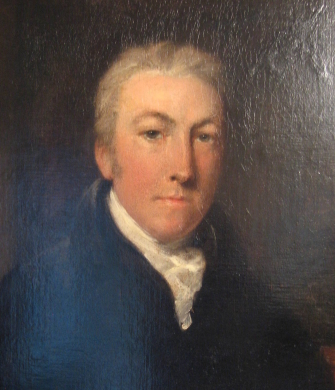
Rt. Hon. Sir John Stewart, 1st Bt
b. 1757, d. 22st of June 1825.
JOHN STEWART, Esq, of Athenree, b. 1757; m. 4th of June 1789 Mary, daughter of Col. Mervyn Archdale, Esq. of Castle Archdale, Co. Fermanagh, and Hon. Mary Dawson.
John Stewart attained eminence at the bar, he was appointed attorney-general of Ireland in 1799, and sworn onto the privy council of that kingdom. He subsequently represented the counties of Down and Tyrone in parliament, and was created a Baronet (Rt. Hon. Sir John Stewart, 1st Baronet Stewart, of Athenree, co. Tyrone) on 14th of June 1803, he d. 22nd of June 1825, having had issue;
- Barbara; m. Henry Moutray, son of John Corry Moutray and Mary Anne Catherine Upton, in 1856. she d. 1876.
- Mary; d. 1810, unmarried.
- Phoebe Julia, m. 1857 Edward Hornidge.
- HUGH, b. 14 May 1792, d. 19 Nov 1854, his heir.
- Mervyn; b. 27th May 1794, m. Frances Vesey, daughter of Reverend George Vesey and Barbara Taylor, on 1 June 1822, He emigrated to Katikati, New Zealand, arriving in 1879. he d. 13th Sep 1886.
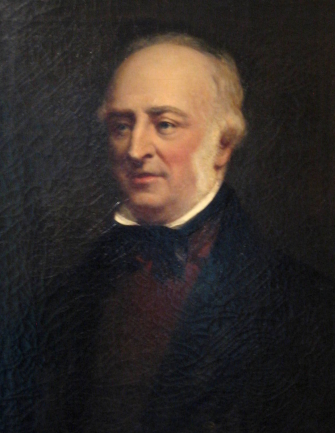
Sir Hugh Stewart, 2nd Bart.
b. 14th of May 1792, d. 19th of November 1854
SIR HUGH STEWART, 2nd Baronet (1792-1854), MP for Tyrone, 1830-35, m. 1stly, in 1826, Julia, daughter of Marcus Gage (son of Conolly McCausland of Fruit Hill & Elizabeth Gage, shared ancestor of Amy Eccles and Raymond Browne-Lecky of Ecclesville), and Julia Sterling, and had issue,
- JOHN MARCUS, his heir;
- Julia.
- Hugh;
- Henry Lucas St George;
- Elizabeth; Mary; another daughter.
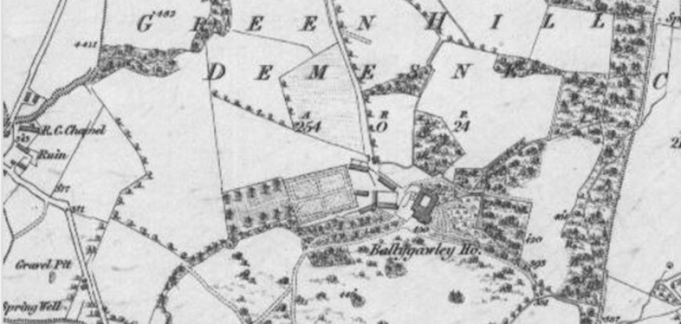
© Crown Copyright and Database Right (2015) | Ordnance Survey of Northern Ireland.
Sir John Stewart, 1st baronet of Athenree, acquired the property known as Green-hill at Ballygawley Co. Tyrone c.1810/11, it previously occupied by Mr Thomas Harvey Esq., who thereafter settled in Newry, Co. Down.
- Green Hill Demesne (Tulaigh Ghlaise) , Errigal Keerogue Civil Parish, Barony of Clogher, Co. Tyrone 262 A, 1 R, 1 P.
At the Assizes of Armagh, a cause came on to be tried before the Honourable Justice Fox, wherein Thomas Harvey, of Green-hill, in the county Tyrone, Esq. was plaintiff, and Richard Armstrong, of Ballygawly in said county Esq. defendant, to recover the amount of two promissory notes, for 75l. each, drawn by the defendant, in favour of the plaintiff. The notes were executed on the terms the statute of bankruptcy being superseded, which issued against a person of the name Thomas Findelater, of Aughnacloy, in said county of Tyrone. The plaintiff, notwithstanding the statute never was superseded, brought his action to recover the amount of the notes, when, after a minute investigation of the case before a most respectable Jury, and the eloquent charge of the learned Judge, the Jury retired for a few minutes, and found a verdict for the defendant, with six-pence costs.
Belfast Commercial Chronicle - Wednesday 26 July 1809
Sir Hugh Stewart, 2nd Baronet, re-named Greenhill, to Ballygawley Park, he built a mansion house c.1825-33, to a design by John Hargrave of Cork, constructed with freestone from the local area. The Stewart's had anothery house nearby at Loughmacrory,
'In 1837, Lewis describes "Loughmacrory" as the seat of Sir Hugh Stewart, Bart. JP & DL (1792-1854) 2nd Baronet "of Ballygawly House & Loughmacrory Lodge" who was MP for County Tyrone, 1830-35.'
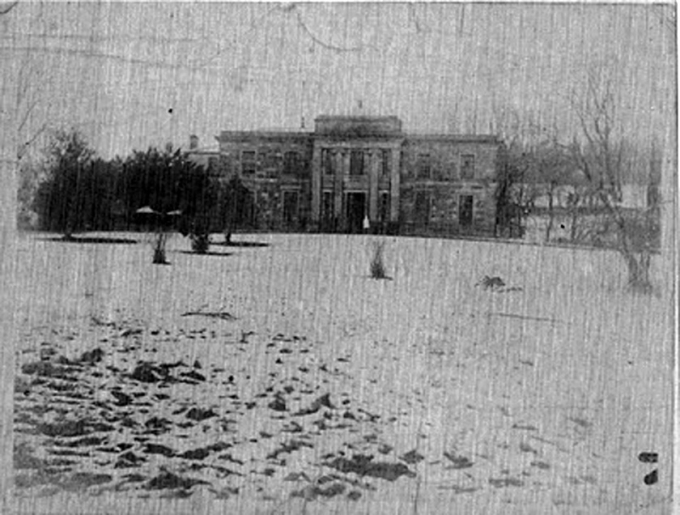
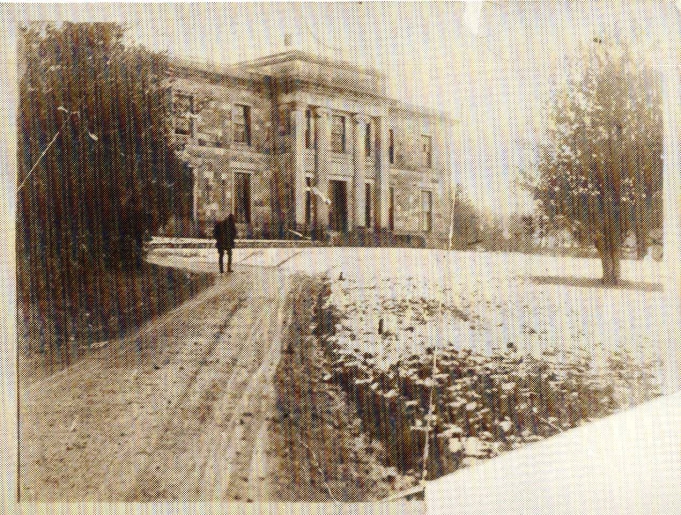
In September 1854, the Ballygawley estate, amounting to 5,440 acres was advertised for sale:-
COUNTY OF TYRONE.
THE BALLYGAWLEY ESTATE.
In the Matter of the Estate of Sir Hugh Stewart, Bart., and John Marcus Stewart, Esq., Owners and Petitioners. PROPOSALS will be received up to the 1st of JANUARY next, for the Sale, with Parliamentary Title, by Private Contract, in One Lot, and immediate possession of the House, Demesne, and Lands of BALLYGAWLEY, together with the Town and Sixteen adjoining Townlands (the demesne being nearly in the centre), the entire held in Fee-simple, containing 5,440 A., statute measure, and situate in the baronies of Dungannon and Clogher, and COUNTY OF TYRONE. This Estate produces clear nett Annual Rental or Income of £2,833, exclusive of the House and Demesne. Few more desirable opportunities for investment can offer; the Tenants, few in number, are most respectable, orderly, industrious, and solvent, and the Estate lies in the best part of the county. Ballygawley House and Offices are of modern construction—the former fully furnished, perfect order and condition, and fit for the immediate reception of a Nobleman’s or Gentleman’s family. Unless in one Lot by Private Contract, and within the time specified, this Estate will not be disposed of. For further particulars, apply to
SAMUEL FREDERICK ADAIR, Solicitor for
the Owners (at whose Offices, 27, Upper Pem-
broke-street, Dublin, Rentals and Maps of the
Estate may be seen); and
WILLIAM CHARLES GAGE, Esq., Agent
over said Estate, Newtownlimavady, County
Londonderry.
Dublin Evening Post - Thursday 21 September 1854
Sir Hugh Stewart, 2nd Bart, died on the 19th of November 1854, a record of the Incumbered Estates Court deposited at PRONI (D4183/23/6) dated the 18th of January 1855, details the Tyrone estate;
'the Rental and particulars of sale of lands for the estate of Sir Hugh Stewart and John Marcus Stewart in Co. Tyrone; the townlands being
Gortigal, Aghalarg, Gortatray, Edergole, Kiltamnagh, Stroancarbadagh, Tullycunny, Rakeeragh, Creevanmore, Drudgeon, Blacksessogue,
Lisanelly, Altcloghfin, Martray, Coolagerry, Killyneery, Armalughey and Cravenny Scotch. Included are maps of the properties for sale.'
- Albert Fortescue, d 1925;
- HUGH HOUGHTON, his successor;
- GEORGE POWELL, successor to his brother;
- John Marcus;
- Charles Gage;
- Cosmo Gordon;
- Julian Leslie (Rev);
- Annie Coote Houghton; Mary; Madeleine Delamont; two other offspring.
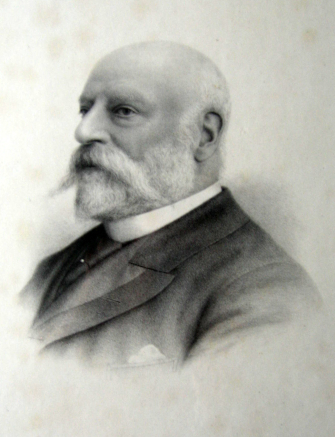
Sir John Marcus Stewart, 3rd Bart.
b. 19th of November 1830, d. 26th of February 1905
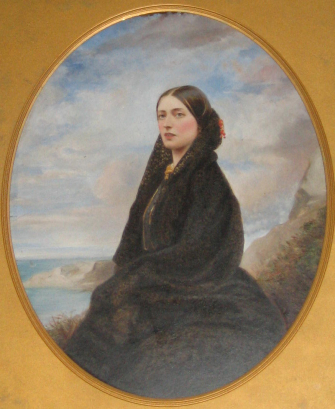
Annie Coote Stewart nee Houghton.
WALFORD'S,
COUNTY FAMILIES
OF THE UNITED KINGDOM (1902):-
STEWART, Sir JOHN MARCUS, Bart., of Ballygawley, co. Tyrone.--Cr. 1803.
Eldest son of Sir Hugh Stewart, 2nd Bart., of Ballygawley, by Julia, who d. 1830, dau, of Marcus M'Causland Gage, Esq., of Bellarena; b. 1830; s. 1854; m. 1856 Annie Coote, dau. and coheir of the late George Powell Houghton, Esq., of Kilmannock. Educated at Rugby; is a J.P. and D.L. for co. Tyrone (High Sheriff 1858); late Lieut. Inniskilling Dragoons;
Ballygawley Park, Tyrone; Fincoul Lodge, Omagh, and Carrickmoyle[sic] House, co. Tyrone; Carlton Club, s.w.
Heir, his son Hugh Houghton, Lieut-Col. 3rd Batt. R. Inniskilling Fusiliers, Late Capt. R. Irish Rifles (on the roll for High Sheriff of co Tyrone 1903); b. 1858. [sic]
Wodehouse, John, et al. The journal of John Wodehouse, first Earl of Kimberley, 1862-1902. London, Cambridge University Press, 1997.
In 1871, building works were carried out at Ballygawley Park:-
NOTICE TO BUILDERS.
PROPOSALS WILL BE RECEIVED FOR
The erection of a FARMSTEAD, together
with Alterations and Additions to the
STABLE, OFFICES, and other Works at BALLYGAWLEY PARK, County Tyrone, the seat of Sir John Marcus Stewart, Bart. Also, for the erection of THREE DWELLING HOUSES at BALLYGAWLEY, according to Plans and Specifications to be seen at the Offices of FITZGIBBON LOUCH,
Esq., C.E., Architect, 45, Donegall Place, Belfast,
to whom Sealed Tenders are to be delivered on or
before the 13th May.
The lowest or any Tender will not necessarily
be accepted, 18 Apr 1871.
Belfast News-Letter - Tuesday 09 May 1871
BALLYGAWLEY.
COME NOTES AND NOTIONS.
(By John Dorrian.)
No. VI.
Fermanagh Herald - Saturday 16 January 1904
We have all, at some time or other, heard of Homer, "Helen" and "Fair Troy" and were I a poet (which I'm not) Ballygawley would be my theme; and it’s a question if ever I'd stop singing its praises.
It has been wisely and truly said that "Poets are born, not made." The "made stuff." from a poetic point of view, does not touch the soul and small wonder, either.
Everything is inborn with the "real" fact, and his effusions are as soothing to the nerves as a Poor Man's Plaster on a weak chest. No one most needs expect poetry from me. The reading of it would be about as pleasant to the ear as the noise of a file on the teeth of a saw.
The reasons for the foregoing preface are:—Some suggested I should write a verse or two about Ballygawley. I confess my inability, and regret that I was not born a Poet.
But to the prose: Would you believe It that the population of this town was some years ago close upon 1,000; and to-day we number, all told, little more than one-fourth of that.
At the time of the Plantation in Ulster Ballygawley was known by the name of Moyenner or Ballegalin. There were different other names, and finally its present name. From King James I. a Captain William Turvin had a grant of 1,000 acres of the lands of Moyenner (Ballygawley) and Turvin was to "plant" some English and Scotch in the town and lands. He failed, however, to comply with the terms of his patent, and the place fell into the hands of Sir Gerald Lowther, an English Knight. A Commission sat in 1611, and we are that this Turvin about which nothing is known, save that he was a captain, took possession in person.
Turvin's brother was also resident, "since March last," and had materials provided for buildings. Turvin did not build, neither did he bring the families from England, and the erection of the bawn and house was left for Sir Gerald Lowther.
Pynnar. in his survey, says:— "Sir Gerald Lowther had 1,000 acres called Moyenner and Ballegalin. There is a bawn of clay and stone, with two Bankers, eight feet high.
This is let to one Mr. Pringle: who is dwelling on the land in a poor cabin; but what tenants he had I know not, for he refused to show them unto me; but he brought me a list of just twenty tenants; but I know not whether they have any estates, for the list doth not make any mention of what they hold. As I passed over the lands I saw divers ploughing, and this is all I can say of him." Methinks I have read the names of those tenants somewhere, probably in Hill's Plantation of Ulster, a very large publication which was kindly lent to me some years ago by the late Mr. John Givan, ex-M.P. and S.C.S., Martray Manor, Ballygawley. I do not say for a certainty that I saw them in Hill's, but I've a faint recollection of coming across a list of MacRorys, Earlys, MacSorleys, Turlough O'Brynes, and numerous other families of the O's and Mac's. At the time of Pynnar's Survey Ballygawley was in part of Ridgeway's grant of Ballymackel or the Manor of Thomas Court.
Subsequently it passed into the hands of Archibald Hamilton, the son of Archbishop Hamilton, and owner of the lands of the Moyenner.
There's an old atlas of Ulster (1609), of which I have seen tracings by Lady Violet Lowry Corry, of Castlecoole, Enniskillen, and on this it is called Cavanballygallin. It was from Sir Gerald Lowther that the estate passed into the hands of Archibald Hamilton, and we read that an inquisition was held on 4th January at Ballygawley. Archibald Hamilton, son of the Archbishop, was second husband of Anna, daughter of Lord Balfour (Lady Weymys).
At Dungannon a further inquisition was held in 1662 into the estate of Archibald Hamilton, late of Ballygawley. It was then found in the hands of his brother Hugh, Baron Hamilton of Glenawley, who was unmarried. Subsequently it passed to his daughter, Nicola Sophia, Lady Beresford, who gave it to her second husband, Lieutenant-General Gorges, thence it descended to its present owner, Sir John Marcus Stewart, Bart.
Sir John does not now reside at Ballygawley Park though there is a caretaker at the place, and his permanent residence is at Carrickmore Hall, once Termon-ma-Gurk.
Ballygawley has its castle which was destroyed by the insurgents under Sir Phelim O'Neill, in 1642. We have stated Lady Beresford's connection with the place and there isn't a castle in Tyrone—long before they fell into the hands of Lord Mountjoy—but what had its own particular ghost story, and Ballygawley seems to have been no exception to the rule. Something of a foul nature was enacted, so the story runs, in this castle. now in occupation of Mr. Francis Loughran, blacksmith. Lady Beresford is connected with the "Ballygawley Castle Ghost Story." and as far as I can remember the Gorges family are also mentioned in the same connection.
Time works wonders. When William IV. was King, good natured old sailor was William, and Sir John Ross sailed on a voyage of discovery to the North Pole. Ballygawley situated as it is 13 miles S.E. front Omagh, and 74 miles N.W.by N. from Dublin, boasted of having not only 250 habitable dwellings, but also a population of 972. Didn't I tell you but at the beginning of my paper we had nearly 1.000? What a change in the of King Edward VII. The number of houses have gone down, and the people—well then, they are not here. That 700 or 800 souls should desert us in the space of time noted is somewhat startling. Still we must not forget the ravages of the famine in 1847 and emigration which continues to this day, to the United States and Canada. "Emigration so vast as that by which Ireland was drained of the most re-productive part of its people from 1845 to 1851 could not have failed to draw after it a continuing efflux of the population, and then again the proverbial strength of family ties amongst the Irish people, and their apparently irresistible tendency to re-unite at the earliest opportunity had something to do with the thinning of the country of its people."
The above news article states that a caretaker is in residence at Ballygawley Park by 1904 and the Stewart family are residing mainly at Carrickmore Hall, the 1901 census for Ireland shows the caretaker and gardener to be Joseph Somerville, in 1911, he is still the resident caretaker and also recorded as being a 'Pensioner from Regiment 27th Inniskilling Fusiliers'.
| Surname | Forename | Age | Sex | Relation to head | Religion |
|---|---|---|---|---|---|
| Somerville | Joseph | 40 | Male | Head of Family | Roman Catholic |
| Somerville | Bridget | 31 | Female | Wife | Roman Catholic |
| Somerville | Susan | 10 | Female | Daughter | Roman Catholic |
| Somerville | Mary Ellen | 8 | Female | Daughter | Roman Catholic |
| Somerville | Bridget | 5 | Female | Daughter | Roman Catholic |
| Somerville | Joseph | 3 | Male | Son | Roman Catholic |
| Somerville | Elizabeth | Female | Daughter | Roman Catholic | |
| Mc Cavana | Bernard | 45 | Male | Boarder | Roman Catholic |
Tyrone Constitution - Friday 03 March 1905
Death of Sir John Marcus Stewart,
Bart, DL.
We deeply regret to announce the death of this well-known and highly-esteemed gentleman, which took place on the 26th inst. after a brief illness. The sad news will come as a painful surprise to most of his friends, for notwithstanding his advanced years, Sir John had a robust constitution, and enjoyed wonderfully good health until a few weeks ago, when he was seized with an illness which caused much anxiety to the members of his family, though it was not then anticipated that it would have a fatal termination. Last week he was brought to Belfast to undergo treatment at the private hospital in Fitzroy Avenue and here he had the advantage of the best medical skill and most efficient nursing. An operation was deemed necessary, and this was successfully performed on the 22nd inst. by Surgeon Kirk, Professor Sinclair, and Dr. Robert Reid, of Whiteabbey. It was confidently believed that a speedy recovery would follow, but unhappily, in spite of all that professional skill could accomplish, this hope has not been realised, for the patient never regained strength and becoming gradually worse passed peacefully on Sunday last, to the inexpressible grief of his wife and family, and the sorrow of all who knew him.
The late Sir John Marcus Stewart, Bart, of Athenry, County Tyrone, was born on the 19th November, 1830, so that he was in his seventy-fifth year. He was the eldest son of the second baronet, Sir Hugh Stewart, and Julia daughter of the late Mr. Marcus M'Causland Gage, County Derry. He was educated at Rugby, and after leaving that famous school adopted the profession of arms, joining as lieutenant the 6th Inniskilling Dragoons, in which regiment he saw active service during the Crimean war. He was invalided home for a time, but returned to the scene of hostilities, and there remained until the death of his father in 1856 led to his withdrawal from the prior to the conclusion of that historic campaign. On succeeding to baronetcy, which was created in 1803, and to the ownership of the extensive estates in Tyrone and other counties, Sir John threw himself with characteristic energies into the duties which devolved upon him in his new position. He was a most generous and considerate landlord, who was regarded by his tenantry with feelings the deepest respect and affection, for they found in him one who was ever ready to give them a courteous and attentive hearing, and who in divers wavs proved that he had their welfare at heart. His genial and kindly disposition endeared him indeed to all who were brought into contact with him, and there was man in County Tyrone held in greater or more general esteem. He had the gift of making and retaining friends, and was probably one the few men who never made an enemy. He took an active part in the affairs the county, which has sustained a severe loss by his lamented death. He was one of the oldest members —if not the oldest member—of the Grand Jury, and for many years rendered valuable service as a governor of the county asylum and also of the infirmary in Omagh. He was a justice of the peace and deputy-lieutenant of the county, and had filled with marked ability the important office of High Sheriff. During the years which the first Duke Abercorn held the Vice-royalty-1806-68 and 1874-70 —Sir John acted Gentleman Usher to the Lord Lieutenant, and in this capacity had official duties to discharge in connection with one the visits of his Majestv the King--then Prince of Wales—to Dublin. In politics he was an ardent Conservative, and he was a very pronounced Churchman, being closely identified with the work of the Church of Ireland as a member the Diocesan Synod and otherwise. He was a liberal supporter of many good causes, and practical sympathiser with philanthropic and benevolent organisations. He was a member of the Loyal Orange Institution, and was also connected with the Masonic Order, being Provincial Grand Master for Tyrone and Fermanagh.
His residences were Ballygawley Park, Ballygawley; Carrickmore Hall, Carrickmore; and Finn Coul Lodge, County Tyrone. Sir John Married in 1856 Annie Coote, daughter and coheiress of the late Mr. George Powell Houghton of Kilmannock House, County Wexford, and had a family of nine sons and three daughters. Lady Stewart, the daughters, and six of the sons survive him, and sincere sympathy will be felt for them in their bereavement. The eldest son. Lieutenant- Colonel Hugh Houghton Stewart, who succeeds to the title and estates, and who was born in 1858, saw active service during the recent South African war, and like his father has filled the office of High Sheriff of County Tyrone. As will be seen from the announcement our obituary column, the funeral took place Thursday last.
Northern Whig - Friday 24 January 1913
TYRONE COUNTY COUNCIL
‘A letter was received from Sir Hugh Stewart offering to sell Ballygawley House for a sanatorium, and another letter was received offering the sale of a mansion near Castlederg for the same purpose. The County Council took no action with regard to either offer.’
Sir Hugh Houghton Stewart disposed of Ballygawley Park in 1918, to Mr. Hugh M’Laurin, J.P., of Messrs. M'Laurin Bros., jam manufacturers, Belfast for £6,000.
Mr M'Laurin, never occupied the house, an advertisement from June 1920, invites tenders for the building materials used in the construction of the mansion house:-
Belfast News-Letter - Monday 07 June 1920
MANSION HOUSE,
GREENHILL DEMESNE
BALLYGAWLEY, CO. TYRONE
BUILDING MATERIAL
TENDERS ARE INVITE FOR THE BUILDING MATERIAL OF THE ABOVE MAGNIFICENT MANSION HOUSE. The house is built of cut stone and very large quantity of slate, lead. and teak wood was used in its construction. The entire buildings must be removed not later than the 1st day of January, 1921. Tenders will received by undersigned up till 1st day of JULY. 1920. Lowest or any Tender not necessarily accepted. Further particulars from
M'LAURIN BROS.,
Oxford Street, Belfast.
JAMES A. CULBERT, Solicitor,
11, Chichester Street, Belfast.
Although Sir Hugh had disposed of the property in 1918, he had an ongoing dispute with the auctioneers, regarding their costs and fees incurred, it was only settled in February 1922, by wich time the building had suffered severe damage from a fire that took place on the 17th of February 1922.
The fire was blamed on the IRA, who it was claimed believed that the RIC, had recently been looking at taking the building over to use as Barracks, and the fire put an end to that, although the IRA never publicly claimed responsibility, there was talk at the time that maybe there was more to it than simply being the IRA that were responsible and when the owner of the property quickly filed a compensation claim for £20,000, only a few days after the fire had taken place, it only fuelled the gossip, the property had been bought for £6,000 only a few years before.
The remains of the house and demesne were sold following the fire.
Belfast News-Letter - Saturday 18 February 1922
TYRONE INCENDIARISM.
Mansion Gutted Hear Ballygawley.
A fine old mansion at Greenhill, which it; was rumoured some time ago was to be taken over by Crown forces, was maliciously set to fire Yesterday morning and reduced to ashes. The building, which was unfurnished and unoccupied, stood in its own grounds, about a mile from Ballygawley, on the Omagh road. It was formerly the seat of the Stewarts, Co. Tyrone, and was sold in 1918 by Sir John Stewart for £6,000 to Messrs. M'Laurin Bros., jam manufacturers, Belfast, the present owners.
The fire was first observed by "B" specials just before daylight, but on approaching the building it was seen at a glance that the propertv was doomed, and that attempts to save it would be futile, as there was no water supply in the vicinity, and the flames had already a substantial hold of the entire fabric. Word was conveyed to the R.I.C. and specials’ barracks at Aughnacloy, and District-Inspector Martin. Captain Baker, and party of men proceeded to the spot in motors, but they could do nothing.
It seems that quantities of hay, saturated with petrol, had been placed in nearly all the rooms in the mansion and set ablaze, two petrol tins being found in one of the rooms by the police. It is thought the miscreants came over the fields early in the morning, as a Crossley car of Specials patrolled the roads till an advanced hour. Captain Baker had his coat and cap destroyed and his head slightly burned by molten lead falling as entered the building.
The police say they had no intention of taking over the building present, though they had examined it with & view to that purpose recently.
Belfast News-Letter - Monday 27 February 1922
RECENT TYRONE OUTRAGE.
Claims for Compensation.
The following claims for compensation for alleged malicious injury were notified to Clogher Rural Council on Saturday:- Mr. M'Laurin, J.P., Belfast, £20,000 for the burning of Greenhill mansion, Ballygawley, on 17th Feb.
SALE OF BALLYGAWLEY PARK
In the King's Bench, Dublin. yesterday, before Mr. Justice Samuels, in a case John and William M’Cann, auctioneers, Aughnacloy, against. Brigadier-General Sir Hugh H. Stewart, Bart, described as of Loughmacrory Lodge, Carrickmore, County Tyrone. Mr. James Geoghegan (instructed Mr. John F. Smyth, Carrickmacross) applied on behalf of the plaintiffs to make a consent a rule of court. The action was for commission, fees, and moneys paid in connection with the sale of the defendant's Estate known as Ballygawley Park, which had been sold at £6,000, the plaintiffs claiming that they had found and introduced the purchaser. The total amount claimed £159 12s. The defendant had lodged sum £31 with his defence, but subsequently a settlement was arranged and formal consent signed whereby the defendant undertook to pay £120 in full discharge of plaintiffs' claim, together with plaintiffs’ costs as between solicitor and client, the money lodged in court, to be paid out to Messrs, Dickie & Carson, Omagh, solicitors for defendant.
Mr. Justice Samuels made the order sought.
Northern Whig - Wednesday 01 March 1922
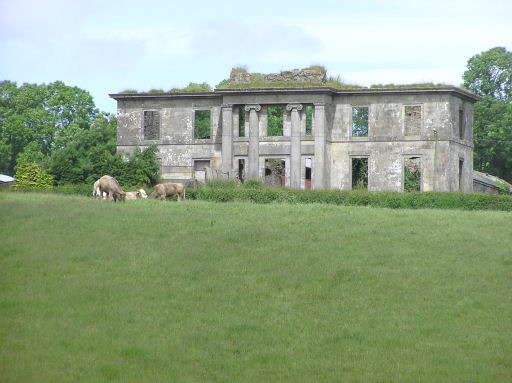
Sir Hugh was succeeded by his brother,
SIR GEORGE POWELL STEWART, 5th Baronet, b. 7th of Oct 1861; Lieutenant-Colonel, Royal Inniskilling Fusiliers, m. 14th of Feb 1895, Florence Maria Georgina, daughter of Colonel Sir James Godfray, ADC, of Grainville Manor, St Saviour's, Jersey, and had issue,
- John Houghton (1895-1915) killed in action;
- HUGH CHARLIE GODFRAY, his heir;
- Mary.
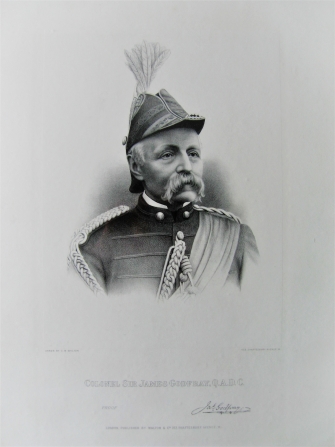
Sir James Godfray, ADC of Grainville Manor, St Saviour's, Jersey.
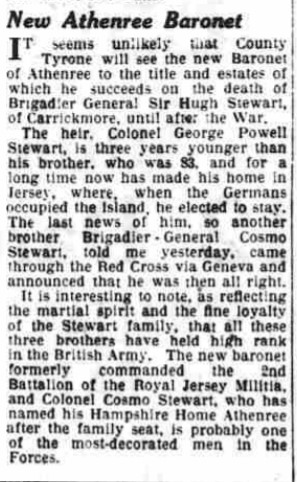

Northern Whig - Monday 26 January 1942
Londonderry Sentinel - Tuesday 27 April 1909
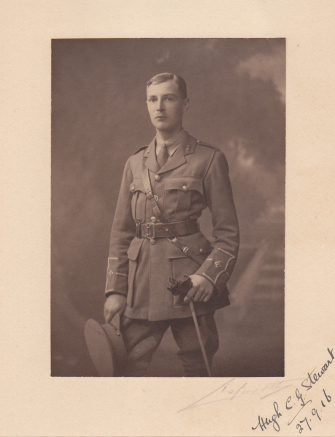
SIR HUGH CHARLIE GODRAY STEWART, 6th Bart,
b. 13th of April 1897, d. 4th of January 1986.
- DAVID JOHN CHRISTOPHER, his heir;
- Elinor Godfray; b. 5th of March 1930; m. the 4th of July 1953, John Michael Macdonell, son of John Forbes of St. Neots, she d. the 21st of Aug 2002, leaving issue.
- Jane Diana; b. 2nd of April 1949.
- Hugh Nicholas (Nick); b. 20th of April 1955; heir presumptive.
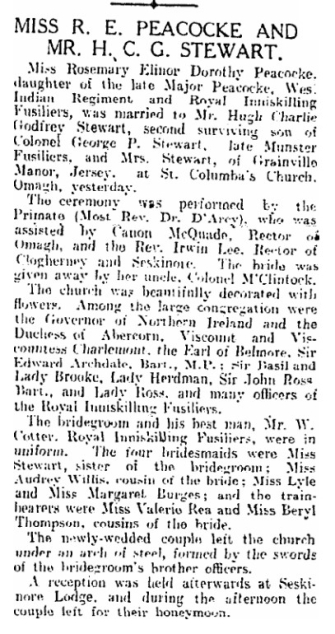
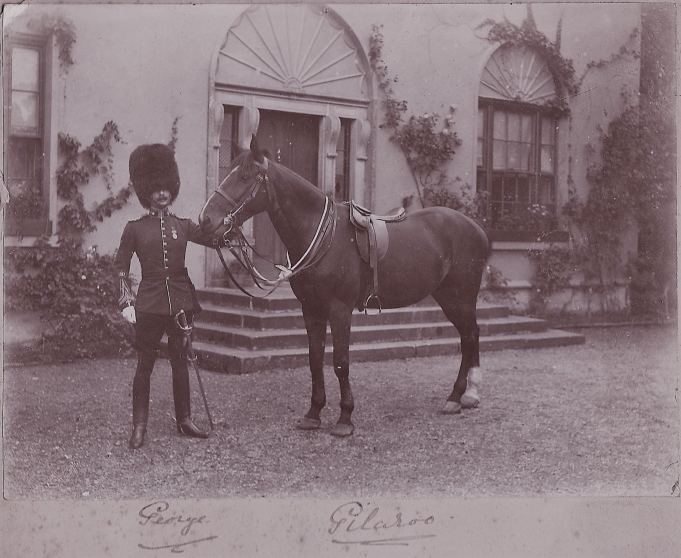
George Peacocke and Gilaroo.
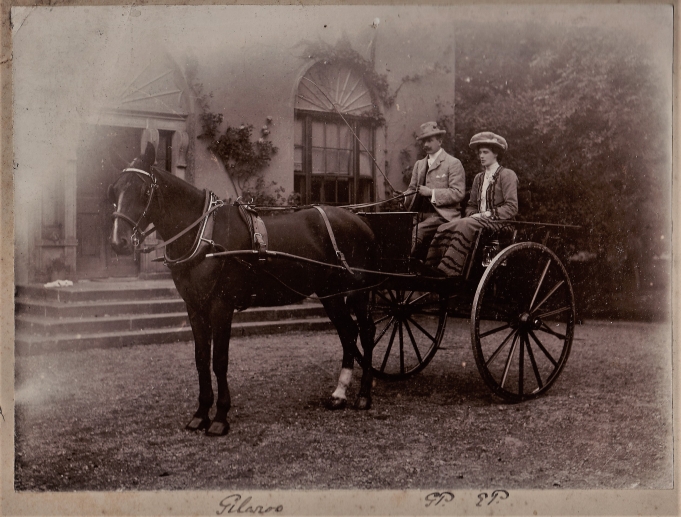
George Peacocke, Elinor (Nell) Peacocke, and Gilaroo. c.1906.
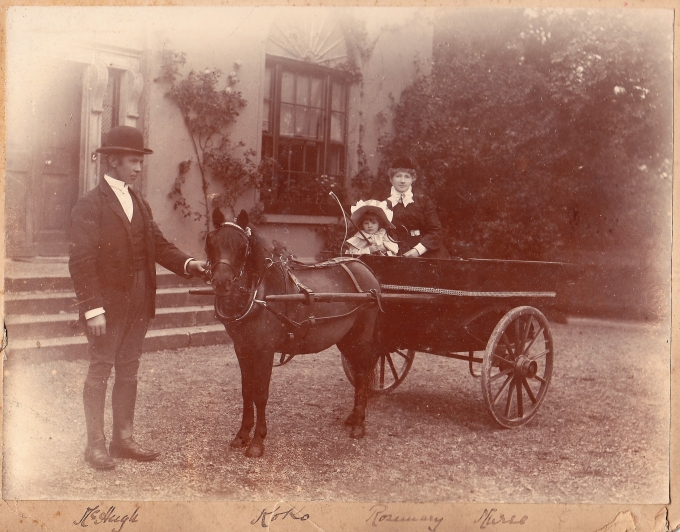
Andy McHugh, Rosemary Peacocke, nurse, and Koko. c.1906.

Andy McHugh, Rosemary Peacocke, and Koko. c.1906.
Leeds Mercury - Friday 27 April 1923
AN OFFICER’S SUICIDE.
Major’s Disagreement
With War Office.
BENTLEY TRAGEDY.
Inquiries into the antecedents of Major Peacock, who shot himself on the roadside at Bentley, near Beverley, on Wednesday, show that he came from Omagh, County Tyrone, Ireland, where his wife and daughter reside. He served in a West Indian regiment from 1899 to 1909, when he retired. He was called up for the late war, but was unable to proceed abroad owing to ill health, and was attached to the Humber Garrison as land agent.
He was later transferred to the Northern Command, but remained stationed at Hull, a condition of the transfer being that he should receive military pay and allowances and not civilian pay.
Instead, however, of receiving military pay, was given civilian pay. He could not get a satisfactory reason for this for several years, and then he discovered was being credited at Cox’s bank with military pay in addition to the civilian pay he was receiving.
Later the War Office demanded the return of the military pay, which he refused to do, but offered to return the civilian pay after deducting allowances. The War Office, however, would not give way, and in 1921 the matter was placed in the hands of the Treasury solicitor who threatened to issue a writ, but did not do so.
In the early part of this year Peacock found that for the past two years he had only been receiving half retired pay, and he wrote the War Office asking for a readjustment. To this, however, he could get no reply. On the 12th March last placed the matter in the hands of a solicitor, who received a reply to the effect that the War Office could not consider any readjustment until the question of the return of the military pay was settled.
Peacock a few days ago came to the end of his resources—he said he could not live on the amount he was receiving —and he left a letter behind him in which he said that his end would call attention to his grievance.
Mrs. Sybil Gabrielle Peasegood, of Desmond avenue, Beverley-road, Hull, said Major Peacock had lodged with her since the end of February. himself one of the unemployed.” He would have done work if he could have got it.
He paid her up to Saturday, and on Monday said he had given her all he had. He had been quiet during the past two or three days, but seemed bright when he left the house on Tuesday morning.
Harold Wardell, farmer's son, who found the body, said. Peacock had a service revolver his right hand, and P.C. Maidment said the weapon contained five live cartridges and one spent.
There was also beside him a leather attache-case full of Army papers and correspondence. These papers showed him to be fifty-two years of age. The only money found upon him was 2 1/2d.
Peacock also left a sealed letter addressed to the Coroner, in which he said had served in the Army twenty-four years, and also recounted at length his grievances, concluding: “After the perusal of the foregoing you may be inclined to agree that ‘murder the War Office’ is the correct explanation of any possible action left for me to take.”
The jury returned a verdict that Peacock shot himself while temporarily insane.”
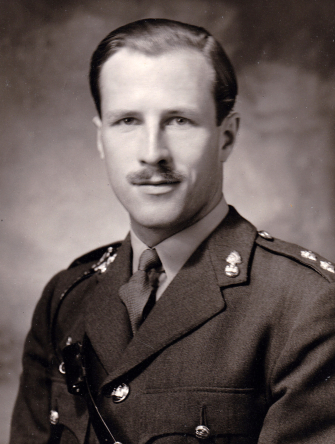
SIR DAVID JOHN CHRISTOPHER STEWART, 7th Baronet,
b. 19th of June 1935.
- Siobhan Amanda; b. 6th of Feb 1961.
- Selina Godfray; b. 30th of Oct 1964.
- Sophie Caroline; b. 3rd of Aug 1966.
His half-brother succeeds him
(Sir) HUGH NICHOLAS STEWART (8th Baronet) has yet to establish claim, b. 20th of April 1955. He m. 1976 Anna daughter of Frank Llewellyn Leeke of Kingsbury, Middx, and had issue,
KIERAN ANDREW LIAM b. 22 Jan 1979.
Cherisma, b. 1974.
Tamesin Kerry, b. 1977.
Lauren b. 1987.
EXTRACT OF MATRICULATION. of the Arms of
Sir Hugh Houghton Stewart of Athenree,
Baronet Sir Hugh Houghton Stewart of Athenree, Fourth Baronet in the Commission of the Peace & Deputy Lieutenant for County Tyrone, Brigadier-General (retired) & late Lieutenant Colonel and Honorary Colonel commanding 3rd Battalion Royal Inniskilling Fusiliers, having by Petition of date the twenty fifth day of January current, unto the Lord Lyon King of Arms, Represented that he was on the fifteenth day of September 1858, & is the eldest son of the late Sir John Marcus Stewart, 3rd Baronet, and his wife [married first December 1856] Annie Coote eldest daughter & co-heiress of George Powell Houghton of Kilmannock, County Wexford; that the said Sir John Marcus Stewart. born nineteenth November 1830, was the eldest son of Sir Hugh Stewart, 2nd Baronet, sometime Member of Parliament for County Tyrone, & his wife [married nineteenth January 1826] Julia daughter of Marcus M’Causland Gage of Bellarena, County Londonderry; that the said Sir Hugh Stewart, Baronet, born fourteenth May 1792, was the eldest son of Sir John Stewart, sometime Attorney General for Ireland, created 1st Baronet of Athenree on twenty first day of June 1803, & his wife Mary daughter of Mervyn Archdale, Esquire, of Castle Archdale; that the said Right Honourable Sir John Stewart, Baronet, born 1757, was the eldest son of the Reverend Hugh Stewart, Rector of Termon in County Tyrone, & his wife [married 1755] Sarah daughter of the Reverend Andrew Hamilton, Archdeacon of Raphoe that the said Reverend Hugh Stewart, born 1711, was the only surviving son of John Stewart of Gortigil, & his wife [married 1710] Mary daughter of Thomas Kennedy of Breigh in County Tyrone; that the said John Stewart of Gortigil, born 1681, was the eldest surviving son of Hugh Stewart of Gortigil, & his wife [married 1675] Margaret daughter of Thomas Morris, Esquire, of Mountjoy Castle; that the said Hugh Stewart of Gortigil was the second son but eldest with male issue of Captain Andrew Stewart of Gortigil, who in or about the year 1620, accompanied Andrew Stewart, 3rd Lord Ochiltree & 1st Lord Castlestewart, from Scotland and whose Kinsman he has always been accounted by family tradition; that the family of Stewart of Gortigil & Athenree has borne Arms from a period anterior to the year 1672, which arms were confirmed & amplified when registered in the office of Arms in Ireland on Twenty Eighth day of November 1808. And the said Petitioner having Prayed that the said Arms, with such difference as may seem proper, might be recorded in the Public Register of All Arms and Bearings in Scotland, the Lord Lyon King of Arms by Interlocutor of this date Granted Warrant to the Lyon Clerk to matriculate in the Public Register of All Arms & Bearings in Scotland in name of the Petitioner Sir Hugh Houghton Stewart of Athenree, Baronet, the following Ensigns Armorial, viz;- Quarterly, First, Or, a lion rampant Within a double tressure flory counter flory Gules, for Scotland; Second, Or, a fess chequy Azure & Argent in chief a portcullis Sable, for Stewart; Third, Argent, a saltire between four roses Gules barbed Vert, for Lennox; Fourth, Or, a lion rampant Gules for Fife, the whole within a bordure compony, Argent & Azure charged with three thistles proper. Above the shield is placed a helmet befitting his Degree with a Mantling Gules doubled Or, & on a Wreath of his Liveries is set for Crest a unicorn’s head couped Argent armed & crined or between two olive branches proper; & in an Escrol over the same this Motto Forward. Matriculated the thirtieth day of January One thousand nine hundred & thirty five. Extracted furth of the Public Register of All Arms & Bearings in Scotland.
Reproduced with kind permission of Sir David Stewart, 7th Bart. of Athenree, Co. Tyrone.
Photographs reproduced with kind permission of Sir David Stewart, 7th Bart. of Athenree, Co. Tyrone.
Photographs of Ballygawley Park/House reproduced with kind permission of Kenneth Allen and lordbelmontinnorthernireland.blogspot.com/
